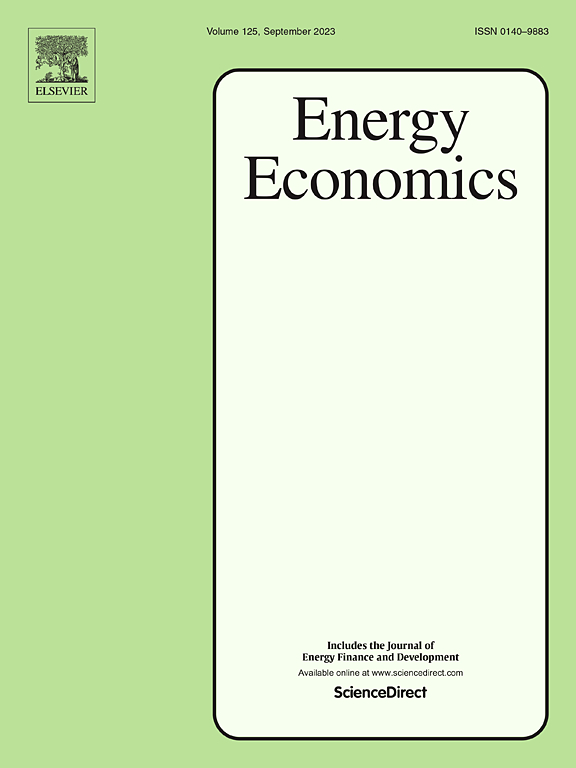实现清洁能源转型:绿色创新和金融发展如何影响能源使用
IF 14.2
2区 经济学
Q1 ECONOMICS
引用次数: 0
摘要
清洁能源的使用在减少对化石燃料的依赖和缓解全球环境恶化方面发挥着关键作用。本研究旨在通过使用共同相关效应估计器(CS-ARDL)研究1990年至2023年期间49个高收入国家绿色创新和金融发展对总能源、清洁能源和脏能源使用的影响,以应对环境挑战。研究结果表明,绿色创新显著减少了总能源和污染能源的使用,同时增加了清洁能源的使用,强调了其在促进可持续能源转型中的关键作用。相比之下,仅金融发展就增加了总能源使用量,以及肮脏能源和清洁能源的使用量。然而,金融发展与绿色创新之间的互动产生了有利的结果,减少了总能源和肮脏能源的使用,同时提高了清洁能源的使用。发现GDP和人口增长与金融发展的相互作用增加了总能源和肮脏能源的使用。此外,金融市场鼓励使用清洁能源,而金融机构倾向于减少使用清洁能源。此外,金融发展、绿色创新、人口和GDP与总能源、清洁能源和脏能源使用呈现双向因果关系。此外,分位数回归分析证实,绿色创新有效地减少了总能源和肮脏能源的使用,同时促进了清洁能源的使用,特别是在较高的分位数。同时,金融发展也降低了较高分位数的总能源和脏能源使用,促进了中等分位数的清洁能源使用。这些发现强调了将绿色创新与金融发展相结合的协调政策对于实现可持续能源体系和应对全球环境挑战的重要性。本文章由计算机程序翻译,如有差异,请以英文原文为准。
Achieving clean energy transitions: How green innovation and financial development shape energy usage
Clean energy usage plays a key role in reducing reliance on fossil fuels and mitigating global environmental degradation. This study aims to address environmental challenges by examining the impact of green innovation and financial development on total, clean, and dirty energy usage in 49 high-income countries from 1990 to 2023 by employing the Common Correlated Effects Estimator (CS-ARDL). The findings reveal that green innovation significantly reduces total and dirty energy usage while increasing clean energy usage, underscoring its critical role in promoting sustainable energy transitions. In contrast, financial development alone increases total energy usage, as well as both dirty and clean energy usage. However, the interaction between financial development and green innovation yields favorable outcomes, reducing total and dirty energy usage while enhancing clean energy usage. The interaction of GDP and population growth with financial development is found to increase total and dirty energy usage. Moreover, financial markets encourage clean energy usage, while financial institutions tend to reduce it. Furthermore, financial development, green innovation, population, and GDP exhibit bidirectional causal relationships with total, clean, and dirty energy usage. In addition, Quantile Regression Analysis confirms that green innovation effectively reduces total and dirty energy usage while boosting clean energy usage, especially at higher quantiles. Meanwhile, financial development also decreases total and dirty energy usage in higher quantiles and promotes clean energy usage in the middle quantile. These findings highlight the importance of coordinated policies that combine green innovation with financial development to achieve sustainable energy systems and address global environmental challenges.
求助全文
通过发布文献求助,成功后即可免费获取论文全文。
去求助
来源期刊

Energy Economics
ECONOMICS-
CiteScore
18.60
自引率
12.50%
发文量
524
期刊介绍:
Energy Economics is a field journal that focuses on energy economics and energy finance. It covers various themes including the exploitation, conversion, and use of energy, markets for energy commodities and derivatives, regulation and taxation, forecasting, environment and climate, international trade, development, and monetary policy. The journal welcomes contributions that utilize diverse methods such as experiments, surveys, econometrics, decomposition, simulation models, equilibrium models, optimization models, and analytical models. It publishes a combination of papers employing different methods to explore a wide range of topics. The journal's replication policy encourages the submission of replication studies, wherein researchers reproduce and extend the key results of original studies while explaining any differences. Energy Economics is indexed and abstracted in several databases including Environmental Abstracts, Fuel and Energy Abstracts, Social Sciences Citation Index, GEOBASE, Social & Behavioral Sciences, Journal of Economic Literature, INSPEC, and more.
 求助内容:
求助内容: 应助结果提醒方式:
应助结果提醒方式:


